Endoscopy Gastroscopy and colonoscopy procedures are performed at our unit by Dr. Yusuf AKÇAN, Assoc Prof. Osman KRAND, and Dr. Aziz Bora KARIP. These procedures are performed under anaesthesia in the presence of an anaesthesiologist.
What is gastroscopy (esophagogastroduodenoscopy), and how is it done?
A gastroscopy can help confirm or rule out the presence of medical conditions in the digestive system like gastritis or peptic ulcers. involves using a thin (8–10 millimetres in thickness and 110–120 cm in length) flexible tube with a light and micro camera at its tip (an endoscope) to examine the upper digestive tract.
To view these areas, the tube is inserted into the mouth and travels down the food pipe (esophagus), then into the stomach and first part of the small intestine (duodenum). The camera and the zones are usually reflected on a television screen, where the doctor depends on them to see the inside surface of the examined area of the patient and make the diagnosis. During this procedure, the patients are usually put to sleep and monitored regularly by checking their pulse rate, oxygen levels, and blood pressure.
What is a colonoscopy, and how is it done?
The diagnostic method that is used to examine the large intestine It is used for diagnostic purposes or for treatment (such as the removal of polyps, etc.) in large intestine diseases, bleeding wounds, abdominal pain, bloody diarrhea, and long-standing diarrhea.
During a colonoscopy, all the parts of the large intestine (the anus, rectum, sigmoid colon, descending colon, transverse colon, and ascending colon) and, if needed, the last part of the small intestine (the terminal ileum) are looked at from the outside to the inside. A colonoscope is a thin, flexible tube with a light and micro camera at its tip that is used during the procedure. Colonoscopy allows for the examination of the inner surface of the large intestine by entering it with a scalpel and a light hose and, if necessary, the removal of various parts (biopsies) from these areas during the operation. During this procedure, the patients are usually put to sleep and monitored regularly by checking their pulse rate, oxygen levels, and blood pressure.
Last Update Date 18 April 2023 Editör Admin Ceyhun Taş - 0541 809 1296














